Honor Award
Bolsa Intervention: Strategizing Performative Ecologies
Oscar Gomez, Associate ASLA and Aaron Reece, Student ASLA, Undergraduate,
California Polytechnic State University, Pomona
Faculty Advisors: Andrew Wilcox, ASLA and Keiji Uesugi, ASLA
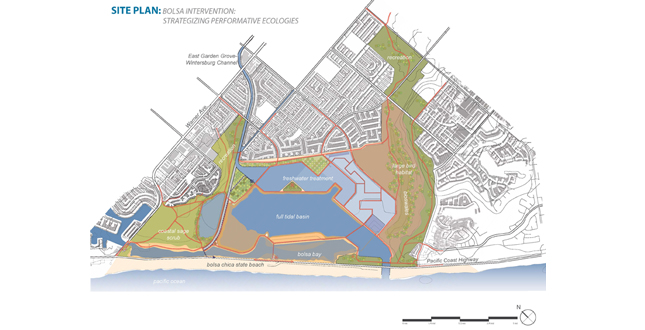
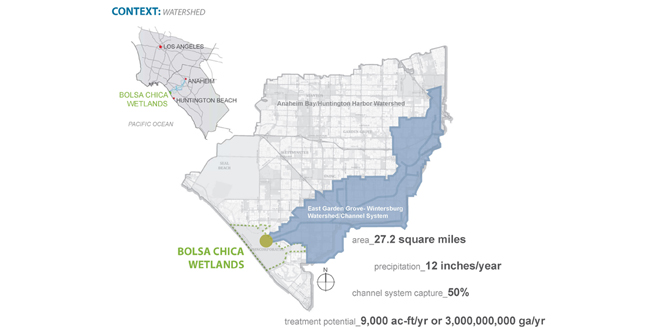
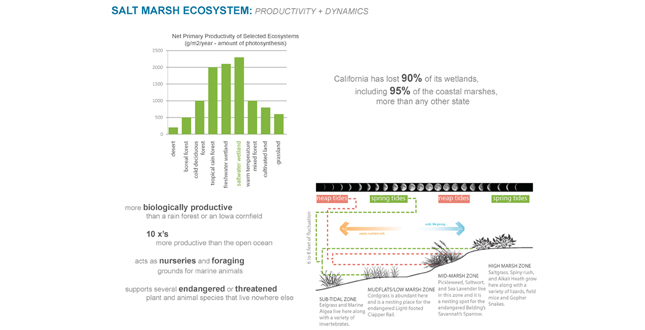 Close Me!
Close Me!Salt Marsh Ecosystem: Productivity and Dynamics
Download Hi-Res ImageImage: Oscar Gomez and Aaron Reece
Image 3 of 12
 Close Me!
Close Me!Transformation: Existing + Removal/Additions
Download Hi-Res ImageImage: Oscar Gomez and Aaron Reece
Image 4 of 12
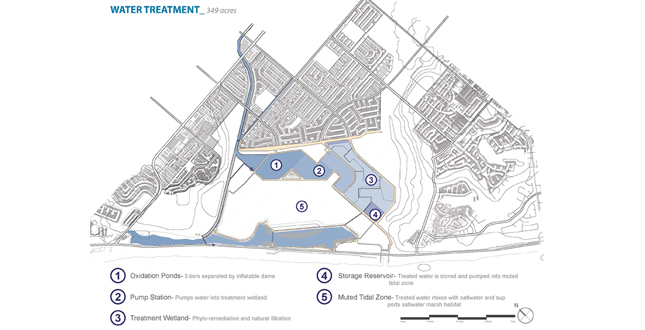
 Close Me!
Close Me!Salt Marsh—289 acres. The most dynamic and biologically significant habitat in the wetlands. A crucial habitat for many different species of plants and animals, many of which are rare or endangered.
Download Hi-Res ImageImage: Oscar Gomez and Aaron Reece
Image 6 of 12
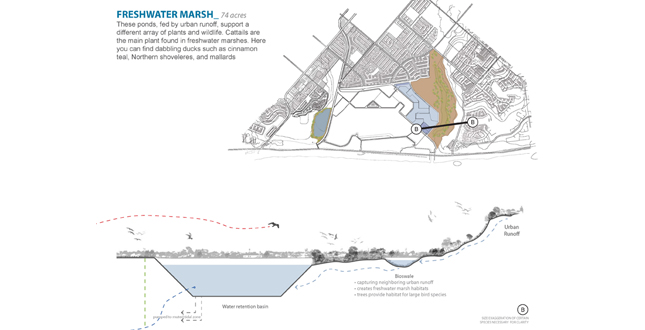 Close Me!
Close Me!Freshwater Marsh—74 acres. These ponds, fed by urban runoff, support a different array of plants and wildlife. Cattails are the main plant found in freshwater marshes. Here you can find dabbling ducks such as cinnamon teal, Northern shoveleres, and mallards.
Download Hi-Res ImageImage: Oscar Gomez and Aaron Reece
Image 7 of 12
 Close Me!
Close Me!Coastal Sage Scrub—305 acres. The plant community includes unique plant species that possess high ecological value and it will provide habitat for a variety of birds and mammals such as the coyotes, rattlesnakes and rabbits.
Download Hi-Res ImageImage: Oscar Gomez and Aaron Reece
Image 8 of 12
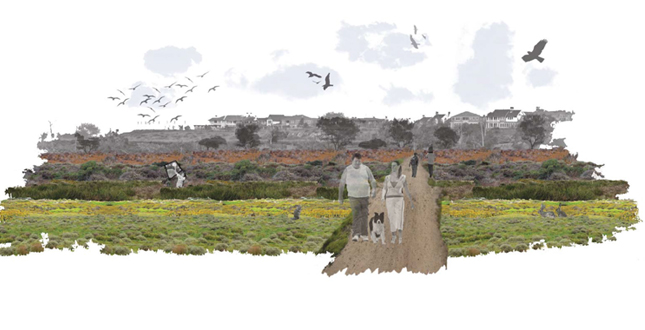
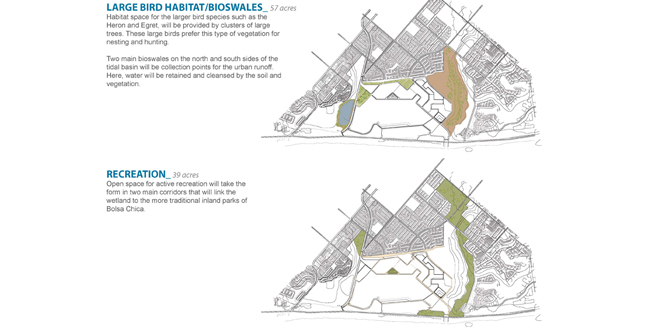 Close Me!
Close Me!Top: Large Bird Habitat/Bioswales—57 acres. Habitat space for the larger bird species such as the Heron and Egret will be provided by clusters of large trees. These large birds prefer this type of vegetation for nesting and hunting. Two main bioswales on the north and south sides of the tidal basin will be collection points for the urban runoff. Here, water will be retained and cleansed by the soil and vegetation. Bottom: Recreation—39 acres. Open space for active recreation will take the form in two main corridors that will link the wetland to the more traditional inland parks of Bolsa Chica.
Download Hi-Res ImageImage: Oscar Gomez and Aaron Reece
Image 10 of 12
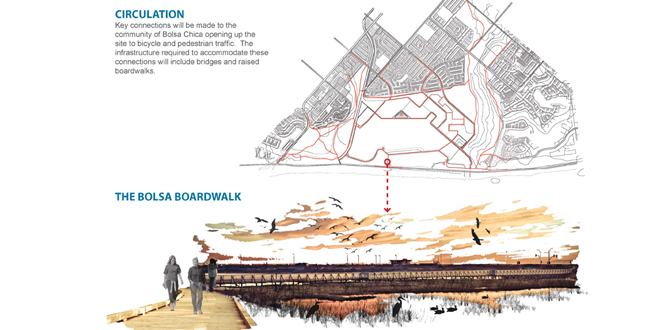 Close Me!
Close Me!Circulation. Key connections will be made to the community of Bolsa Chica opening up the site to bicycle and pedestrian traffic. The infrastructure required to accommodate these connections will include bridges and raised boardwalks.
Download Hi-Res ImageImage: Oscar Gomez and Aaron Reece
Image 11 of 12
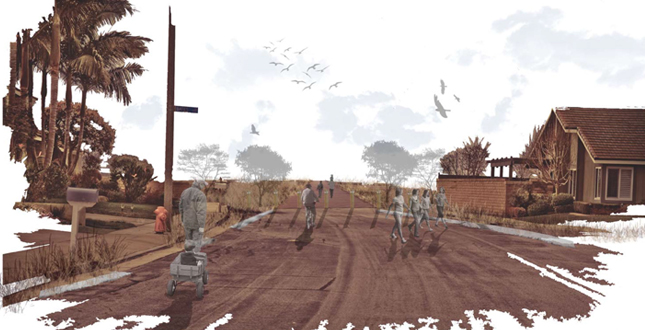
Project Statement
Bolsa Intervention proposes a reconfiguration of the infrastructure at Bolsa Chica Wetlands to treat regional storm water runoff and provide an opportunity for biological productivity in local habitats to be greatly increased. This restructuring of the site will also make key connections to the adjacent communities, drawing people in and fulfilling their innately human need to experience the wild and intricate forces at play in the environment.
Project Narrative
—2011 Student Awards Jury
Brief History
The Bolsa Chica Wetlands is a site of approximately 1300 acres located in Huntington Beach, CA. The site was originally inhabited by the Tongva and Gabrielino Native-American tribes and was a considered a sacred land on which life was dependent. Over the centuries the landscape has been critically altered as it has been host to a variety of uses that have taken place on it because of its unique resources. Until the turn of the twentieth century the land was used for farming, raising cattle, and bird hunting. In 1920, oil was discovered and the land was leased out to oil companies for drilling. During World War II, the United States Military used the site as a major coastal defense post, imposing massive long range guns and artillery storage facilities. In 1970, Signal Oil purchased the land for residential development, greatly impacting ecological function. Oil continues to be pumped on site today with around 85 active oil wells.
The Plan
The landscape is faced with intense pressures from local land-use and infrastructural practices that defy innovation and challenge biological diversity. Yet the site is critically positioned to reframe the methods by which the local culture interacts with and develops its resources. The wetlands will be given new life in this intervention that will not set out to control, but merely set the stage for ecological processes to commence and progress toward a state of equilibrium.
Currently, the wetlands are adversely affected by the terminus of the East Garden Grove Wintersburg flood channel that dumps trash filled and contaminated urban runoff from a sub-watershed of over 27 square miles. The effects of urban runoff on this sensitive coastal ecosystem will be remedied with an extensive freshwater treatment marsh. The East Garden Grove Drainage channel will be redirected to the former oil field site. The form of this reconfiguration will be dictated by the sites current geometric organization. Rather than attempt to recreate a natural geomorphic condition, the new landscape will be transparently artificial and uncontrived.
The first step of the treatment process will be to remove suspended solids and oxygenate the water in a series of oxidation ponds separated by inflatable damns. The contaminated water will then be cleaned further as it will be pumped out to a reservoir and allowed to meander through a network of micro –topographies containing soil, vegetation, and gabion structures(for filtration).
When the water reaches the final storage reservoir, it can be pumped out as needed into the muted-tidal zone where it will be mixed with salt water bringing life to the salt marsh habitat.
Key connections will be made to the community of Bolsa Chica by opening up the site to bicycle and pedestrian traffic. The infrastructure required to accommodate these connections will include bridges and raised boardwalks. Much of the steel and concrete required to build these structures will be recovered from the abandoned oil field. The circulation network with feature a series of viewpoints along the trail, some of which are mounds elevated to give a 360 degree panoramic view of the site.
To mesh with the Bolsa Chica General Plan, this transformation will also incorporate open space for active recreation. This open space will take the form in two main corridors that will link the wetland to the more traditional inland parks of Bolsa Chica.
Habitat space for the larger bird species in the Bolsa Chica Wetlands, such as the Heron and Egret, will be provided by clusters of large trees such as the Black Cottonwood and the Western Sycamore. This will mainly be concentrated in the vicinity of two main bioswales on the north and south sides of the tidal basin where collection points will be established to collect runoff coming from the adjacent neighborhoods. Here, water will be retained and cleansed by the soil and vegetation. The south swale will simply allow water to infiltrate back into the soil. The north will act as an overflow for the channel and can be allowed to flow into the muted tidal zone if necessary.
The restructuring of the wetlands infrastructure will only be feasible once the oil drilling becomes uneconomical for Signal Oil. The main components of the existing site that will require major alteration will be the East Garden Grove Wintersburg flood channel, and the barrier separating the oil fields from the full tidal water basin. Once this transformation takes shape, performance of these intricate ecosystems will be invigorated with life potential and the biological productivity of this unique landscape will greatly increase.
Additional Project Credits
Cal Poly Pomona Department of Landscape Architecture






